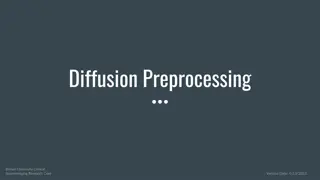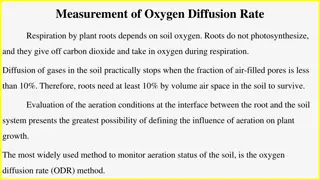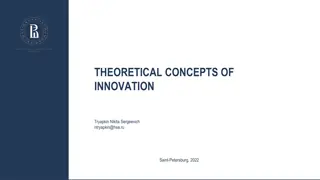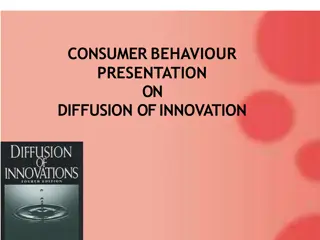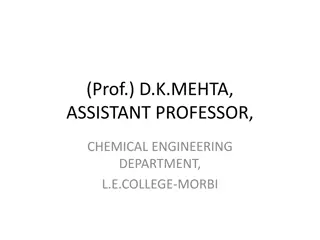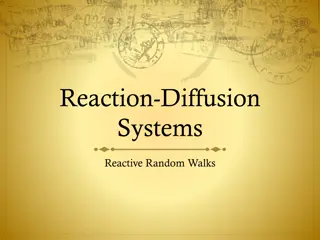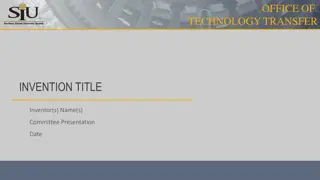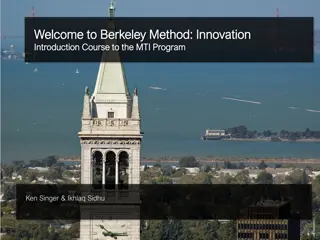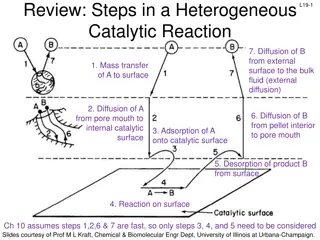Understanding Technological Progress: Invention, Innovation, and Diffusion
Technological progress encompasses the phases of invention, innovation, and diffusion. Invention involves the creation of new ideas or breakthrough technologies, often pursued by various entities. Innovation is the practical application of new or improved ideas, goods, services, or processes. Diffusion is the spread of these innovations across markets. This process is vital for societal advancement and economic growth.
Download Presentation

Please find below an Image/Link to download the presentation.
The content on the website is provided AS IS for your information and personal use only. It may not be sold, licensed, or shared on other websites without obtaining consent from the author. Download presentation by click this link. If you encounter any issues during the download, it is possible that the publisher has removed the file from their server.
E N D
Presentation Transcript
Chapter 8 Technological Progress Technology' we mean any tool or technique, any product or process, any physical equipment or method of doing or making, by which human capability is extended. It is an intellectual act which involves a perception of a new image, of a new connection between old conditions, or of a new area for action. Technological change is a term that is used to describe the overall process of invention, innovation and diffusion of technology or processes. It is used in economics to describe a change in the set of feasible production possibilities.
The Schumpeterian trilogy divided the technological change process into three distinct phases: The technological change process including: the conception of new ideas (invention) the process that involves the development of new ideas into marketable products and processes (the doing of new things or the doing of things that are already being done in a new way) (innovation); and the stage in which the new products and processes spread across the potential market (diffusion). invention innovation Diffusion Three phases of the process of Technological Change
Invention Is the creation of something new, or a "breakthrough" technology. It is the initial creation or discovery of an idea or a product. It is carried on by individuals or corporate bodies like research institutes, universities, government bureaus and companies- the source of invention
Invention will be a goal-oriented activity. A government or corporation will be making invention for solving some social problem or for the sake of extra profits or money. In general invention can be taken as an orderly, intellectual, goal oriented process, a fundamental one, for the innovation or technological change in a society. It does not usually move in a straight line according to the plan, but takes unexpected twists and turns to reach the destination.
Innovation is a logical extension of invention. The process of adopting an invention in a practical use is called innovation. It is the implementation of a new or significantly improved idea, good, service, process or practice that is intended to be useful. It is a change in the thought process for doing something, or it is the useful application of new inventions or discoveries. It may refer to an incremental, radical and revolutionary changes in thinking, products, processes, or organizations.
Following Schumpeter (1934), contributors to the scholarly literature on innovation typically distinguish between invention, an idea made manifest, and innovation, ideas applied successfully in practice. The entrepreneur or manager when performs the act of innovation is called 'innovator'.
Innovation is one of the several strategies through which a firm could change its situation in the market in pursuit of its objectives. It is an instrument, which the firm uses to enhance its competitive power in the market. It provides a basis for greater degree of diversification and hence growth of the firm. J.A. Schumpeter took fundamental impulse that sets and capitalist engine in motion". innovation as keeps the "the
He found innovation as the outstanding fact in the economic history of capitalistic society. Innovation is not confined to such a society only. It is a common feature in almost every economic system whether capitalistic or socialistic or something else. The major elements of innovation or technological change, such as, New products, New methods of production, New markets and New forms of industrial organization etc,
Science and technology become operative through innovation. In the modern world, An individual wants to be more creative, A firm or corporation strives for the progressiveness of its business and A government works for the collective security and welfare of masses. Innovation is an important weapon for all these
In economics field something new change is said to be innovative if the change increase value: customer value, or producer value. The goal of innovation is positive change; to make someone or something better. Innovation leading to increased productivity is the fundamental source of increasing wealth in an economy.
Technological innovation' have two types of innovation. Process-innovation and product-innovation and 'market-innovation (Optional) Process innovation: If a new method is initiated to produce existing products It arises when relative prices of factors of production change. If labor becomes costly, the firm may think of cost saving by adopting capital intensive technique and vice-versa. There will not be any R&D expenditure involved in this, as technology will not change. Only the equilibrium situation for the least cost combination of inputs changes.
Product innovation is necessitated because of a variety of reasons. Primarily, a product change may be stimulated either by a new technology or by a change in relative prices of existing products. Changes in consumer preferences and cost of production- are the sources of change in relative prices of the products. If a product is costly for the firm and at the same time its price declines in the market because of unfavorable circumstances, it will be less profitable and, hence, is likely to be replaced by a new one.
Innovation occurs when the entrepreneur believes that it commercialize the invention. Schumpeter identifies five types of innovation, viz The introduction of a new good- that is one with which consumers are not yet familiar- or of a new quality of a good. The introduction of a new method of production, which need by no means be founded upon a discovery scientifically new, and can also exist in a new way of handling a commodity commercially. is worthwhile to
The opening of a new market; that is a market into which the particular branch of manufacture of the country in question has not previously entered, whether or not this market has existed before. The conquest of a new source of supply of raw materials or half-manufactured goods, again irrespective of whether this source already exists or whether it has first to be created. The carrying out of the new organization of any industry, like the creation of a monopoly position (for example through trustification) or the breaking up of a monopoly position.
Diffusion It is the spread of a technology through a society or industry. The diffusion of a technology generally follows an S-shaped curve as early versions of technology are rather unsuccessful, followed by a period of successful innovation with high levels of adoption, and finally a dropping off in adoption as the technology reaches its maximum potential in a market. It is a situation when an innovation is copied by others. That is, the innovation spreads across the market.
The rate of diffusion of innovation depends on market structure. If there are rigid patent practices and the government assistance in technological progress is negligible, then we expect a low rate of diffusion of the innovation. On the other hand, if technology is freely available, there are no rigid patent practices and investment requirements for the new technology are not alarming, then the rate of diffusion will be fairly high. From social point of view diffusion or spread of the innovation is desirable but from an individual firm point of view it is not, as the firm would not be able to maintain its gains through innovation when it is imitated by its rivals.
When an innovation appears, adoption is slow because few potential users know of it and because its capabilities are relatively uncertain, its purchase represents a risk. As time passes, more potential users come to hear of the process and the experience of the initial users becomes known through the industry, so reducing the risk to buyers. In these conditions, diffusion proceeds more rapidly.
As sales approaches saturation, the number of non-users falls with the effect that pace of diffusion slows once more. Thus, when the share of output attributable to a new process is plotted against time on a graph, the diffusion path will not follow a simple straight line but rather an S-shaped (or sigmoid or logistic) curve.
Figure 7.1: The S-shaped logistic curve and Diffusion of innovation, the Sigmoid Curve
In short, there are three stages in the process of innovation or technological change invention, innovation and diffusion - Diffusion is not possible without innovation which in turn is not possible without invention. The entire process of change, i.e. from invention to imitation, comes under research and development (R&D) activity of the firm.
Patents and Patent Protection A patent is a set of exclusive rights granted by a state (national government) to an inventor or their assignee for a limited period of time in exchange for a public disclosure of an invention. It usually refers to a right granted to anyone who invents or discovers any new and useful process, machine, article of manufacture, or composition of matter, or any new and useful improvement thereof.
Patents provide an inventor with exclusive rights to a new and useful product, process, and substance or design. New products include machines (mechanisms with moving parts) or manufactured articles (without moving parts) such as tools. New processes or methods include chemicals process for treating metal or manufacturing drugs, mechanical processes for manufacturing goods, or electrical process. New substances include chemical compounds and mixtures; this concept covers the composition of matter. Now designs include the shapes of products where the shapes serve of functional purpose. In addition, improvements on products, processes, and substances may be patented.
A patent is not a right to practice or use the invention rather, it provides the right to exclude othersfrom making, using, selling, offering for sale, or importing the patented invention for the term of the patent subject to the payment of maintenance fees. A patent is, in effect, a limited property right that the government offers to inventors in exchange for their agreement to share the details of their inventions with the public. Like any other property right, it may be sold, licensed, mortgaged, assigned or transferred, given away, or simply abandoned.
Patents are legal instruments intended to encourage invention by providing a limited "monopoly" to the inventor (or their assignee) in return for the disclosure of the invention. The underlying assumption being invention is encouraged because an inventor can secure exclusive rights, and therefore a higher probability of financial rewards in the market place.
Patents exist for one economic purpose-to increase the rate of technological advance without question, some major technological breakthrough would never have been developed, or would have been developed much later, in the absence of patent protection. Economic theory suggests, however, that patent protection may not increase the rate of technological advance. In fact, theory suggests that in some cases patent protection decreases the rate of technological advance.


